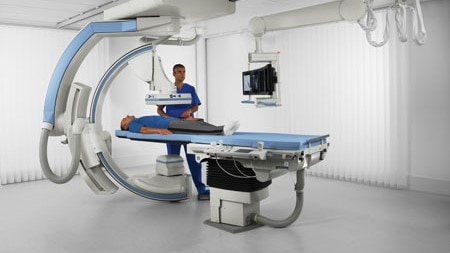At a glance
Fluoroscopy is a medical procedure that allows doctors to see real-time movements inside a part of the body. Your healthcare provider will recommend fluoroscopy when the benefits to your health outweigh the risk.

The basics
Fluoroscopy is a medical procedure that makes a real-time video of the movements inside a part of the body. Images are captured by passing x-rays through the body over a period of time. X-rays are a form of ionizing radiation.
Fluoroscopy can be used for diagnosing (finding out the cause of) a health problem such as heart or intestinal disease. It also can be used to guide treatments such as implants or injections, or in orthopedic surgery. It helps the healthcare provider look inside organs, joints, muscles, and bones.
We all are exposed to ionizing radiation every day from the natural environment. However, added exposures like those from fluoroscopy procedures can slightly increase the risk of developing cancer later in life.
What you should know
Your healthcare provider may recommend a fluoroscopy procedure to diagnose disease or guide treatment procedures for a particular health concern.
Fluoroscopy is commonly used to:
- Check how the stomach and intestines are working.
- Check if food is being properly swallowed and how the muscles of the mouth and throat are working.
- Guide medical procedures to place catheters, stents, or other devices inside the body, such as in the heart or blood vessels.
- Guide injections (shots) deep into the spine or joints.
- See broken bones and whether surgery has fixed them in proper position to heal.
Coronary angiography is an example of a fluoroscopy procedure. A small tube (catheter) is inserted into an artery of the heart. Contrast dye moves through the catheter into the blood vessels. The fluoroscopy shows how the blood moves through the vessels and allows the healthcare provider to locate any blockages.
Fluoroscopy procedures involve exposure to ionizing radiation that can slightly increase the risk of developing cancer later in life.
Your healthcare provider will recommend fluoroscopy when the benefits to your health outweigh the risk. Talk to your healthcare provider if you have any questions or concerns or to decide on the best options for you.
What to expect
Before the procedure
Some fluoroscopy procedures may use a contrast dye which allows medical provider to see specific organ(s). You will be asked to either drink the dye or you will receive it in an intravenous (IV) line.
Make sure to let your healthcare provider or radiologist (medical professional specially trained in radiation procedures) know if:
- You have ever had a reaction to any contrast dye.
- If you have kidney disease or poor kidney function.
- You are pregnant or think you could be pregnant.
You may be asked to take a pregnancy test before the procedure.
During the procedure
- You will be asked to remove any clothing and jewelry that may interfere with the procedure.
- You will be positioned on the procedure table and, depending on the type of procedure, you may be asked to get in different positions, move a specific body part, or hold your breath at intervals while the fluoroscopy is being performed.
- Anesthesia or sedation may be used depending on the procedure.

Benefits and risks of fluoroscopy procedures
- Allows healthcare providers to see movement and function (like in a movie) that cannot be seen in other fixed imaging studies (like a photograph).
- Guides sometimes life-saving surgical treatments.
- Radiation doses are usually higher than in common imaging like X-rays. This means these procedures are slightly more likely to increase the possibility you may get cancer later in life.
- Some fluoroscopy procedures are longer and use more radiation than others. These could cause skin reddening and hair loss.
- Contrast dye, if used, can produce an allergic reaction in some people.
While fluoroscopy itself is not painful, the procedure being performed may be painful. For example, the injection into a joint or accessing of an artery or vein for angiography.
The radiologist will take all comfort measures possible. You may receive local anesthesia, conscious sedation, or general anesthesia, depending on the procedure.
Resources
Federal Drug Administration (FDA)
Image Gently
Environmental Protection Agency (EPA)
- RadTown USA Medical X-Rays
- Radiation Protection Guidance for Diagnostic and Interventional X-Ray Procedures
U.S. National Library of Medicine
